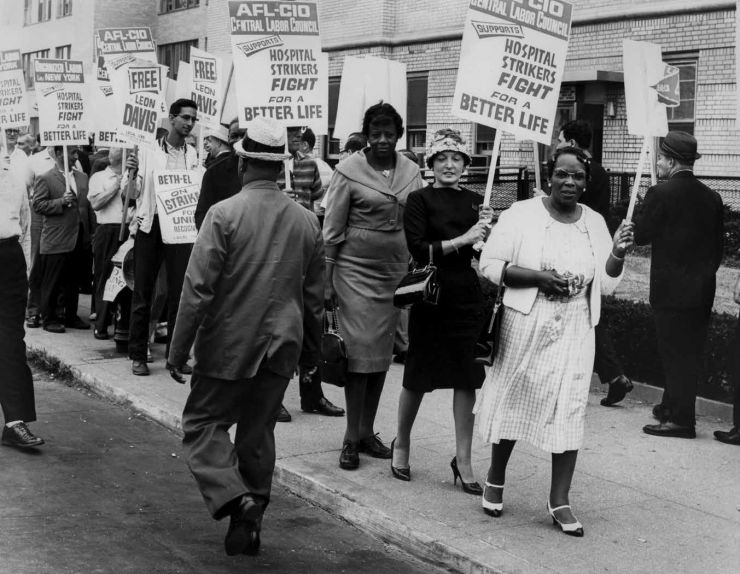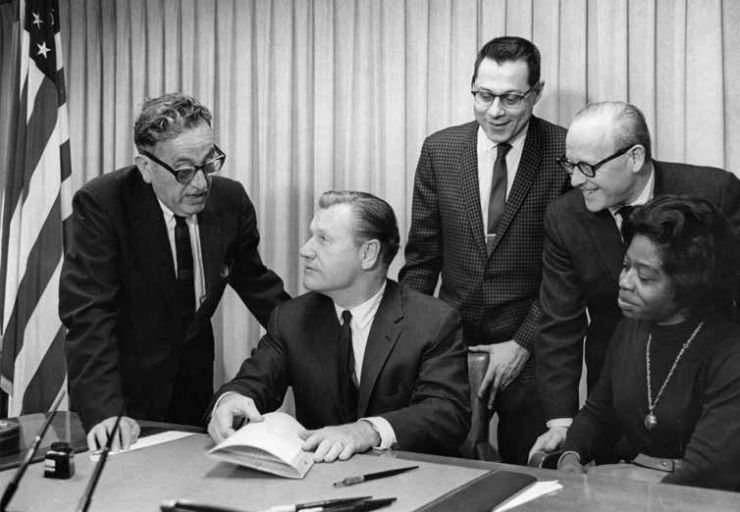Political Battles of the ‘60s Hold Lessons for Long Term Care Fights Today
April 21, 2022
The Albany victory that paved the path for the ‘Gold Standard’ pay and benefits for 1199 hospital workers in NYC.

When NYS Council of Churches head Rev. Peter Cook said last month that, “the time is up for paying these guardian angels a living wage,” he echoed what religious and other leaders said 60 years ago during the early years of 1199’s hospital organizing campaign.
The inequity faced by today’s home care workers in many respects mirrors that of 1199 hospital workers in 1959. Although 1199 won union recognition at seven hospitals after a 46-day strike in that year, workers were forced to strike again at Beth El and Manhattan Eye and Ear hospitals to win collective bargaining rights in New York City as a whole. The then 1199 President, Leon Davis, was jailed for 30 days for refusing to end the strike Working conditions at the overwhelming majority of hospitals were woeful and the service workers – predominantly women of color – were paid barely enough to make ends meet. To win substantial improvements, 1199 leaders recognized the need to form a broad-based coalition with labor and civil-rights organizations at its core.
The movement needed collective bargaining legislation to be passed in order dramatically increase density and boost the organizing campaign to win real victories.

This exclusion reflected a deep racial and gender bias. For example, in order to make Social Security benefits palatable to powerful Southern congressional barons, the Roosevelt administration agreed to a Southern amendment excluding agricultural and domestic employees from coverage. Women of color were especially affected, being the most likely to be employed in the low-wage jobs that involve caregiving, cooking and cleaning.
With this in mind, 1199 along with key allies such as labor legend A. Philip Randolph in 1962 formed the Citizens Committee for Equal Rights for Voluntary Hospital Employees. The committee of more than 200 prominent New Yorkers stressed that the campaign was about more than economic rights. It was also about civil rights.
Adopting the cause of the hospital workers as their own, civil rights leaders termed the fight a moral crusade for justice. A central aim of the citizens committee was to win NY Gov. Nelson Rockefeller’s support for statewide collective bargaining rights. The Republican governor, with ties to civil rights leaders, was sensitive to charges of racist discrimination. He also faced reelection in 1962.
In its publicity campaign, the Union featured mothers who headed households. Those members were prominent in delegations to Albany that lobbied legislators and testified at hearings. The women, many of them recent arrivals from the South and the Caribbean, maintained that unionization and collective bargaining rights not only benefited workers, but also patients, and society as a whole.
Constant lobbying, expert public relations work and the unshakeable unity of the workers at Beth El and Manhattan Eye and Ear led Gov. Rockefeller to announce that he would introduce and push for legislation granting hospital workers collective bargaining rights. Local 1199 agreed to call off the 56-day strike.
In 1963, Gov. Rockefeller signed a bill extending collective bargaining rights to voluntary hospitals in New York City.
Lobbying, notably by the Hospital Association of New York State and the NYS Catholic Conference, prevented extension of the law to the entire state. That would be won two years later.
This historic political victory opened many doors and led to the explosive growth of the Union.
1199 Magazine | March / April 2022

